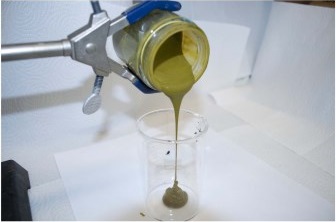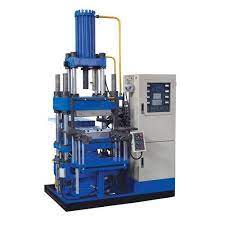At Great Lakes Die Cast, they are trying to make plastic office furniture parts out of agricultural waste.

The company wants to save on the use of oil, protect the environment and remain cost competitive.
Chicken feathers!
Exactly, says company President Con Nolan.
Great Lakes Die Cast Corp. has entered into a development agreement with Eastern BioPlastics LLC of Mt. Crawford, Va. to used the bio-based resin EBP Emerald in producing parts for the office furniture and potentially automotive industries.
Eastern BioPlastics has developed the equipment and methods of turning poultry feathers into the plastic material. For the past year, Great Lakes engineers and technicians have been working with the Eastern BioPlastics material and have produced parts using 40 percent of the bio material mixed with standard plastics.
“This is something that we want to keep our enthusiasm managed,” Nolan said. “But this has the potential for being very good. We hope it takes off in the marketplace. We have the ability to use this within our current customer base.”
Great Lakes Die Cast expects to create a separate division for its plastic and bioplastic parts, Nolan said. The traditional aluminum die casting company ventured into plastics manufacturing in 1990.
And with the Great Recession knocking the company to its knees as the automotive sector melted down and office furniture struggled, company officials said it is not a time to simply hang on. Instead, Great Lakes Die Cast looked for new and innovative ways to diversify itself with new products and new customers, marketing director Dan Gillig said.
“Eastern BioPlastics technology and capabilities made it a perfect fit,” Gillig said of Great Lakes Die Cast. “The partnership allows GLDC to leverage our knowledge and experience in plastic injection molding along with our market access to highly attractive customers in the office furniture and automotive markets.”
The Eastern BioPlastics founder and president has been looking for partners to further the EBP Emerald product. The technology to convert feathers into bioplastics began in the early 2000s with the research and development of Justin Barone.
By 2007, the research scientist brought the technology to Sonny Meyerhoeffer to take the idea to market. Meyerhoeffer, president of Eastern BioPlastics, began the company in April 2008 and used two years to improve the process to cost effectively wash, dry and grind poultry feathers into usable materials.
The raw chicken feathers are fibers that contain the keratin protein also found in fingernails, hair and animal horns. That is the material that gives the bioplastic composites the physical properties comparable to traditional oil-based plastics.
“We are excited about working with Great Lakes Die Cast,” Meyerhoeffer said. “They have the vision and see the benefits — both in terms of cost and environmental impact — our unique resin can bring to their customers.”
Great Lakes Die Cast plastics engineer Tim Swain was skeptical when first approached on using the innovative bioplastics material. He said he began to work closely with Easter BioPlastics officials to get a formula and a plastic injection molding process that would work.
“This is a big change … people aren’t going to be thinking about chicken feathers,” Swain said. “But I think this is going to be a great alternative for our customers.”

The goal is to increase the use of the bioplastics to 60 percent and still meet the standards of the final customer, according to Dean Hodges, director of operations for Great Lakes Die Cast.
The bioplastics are cost competitive and not subject to the wide swings in the price of oil — a key component in plastic, Nolan said. According to the federal government, there are nearly 5 billion pounds of chicken feather waste generated in the United States each year.
The less oil-based material going into parts is better for customers concerned about providing sustainable products that help reduce “greenhouse” gas emissions. While Great Lakes Die Cast works with materials using chicken feathers, other developments are working with flax, straw and corn-based materials to replace the oil in traditional plastics, Hodges said.
Great Lakes Die Cast is making progress with Easter BioPlastics on the new bioplastics materials at a time when the company is coming out of a severe downturn due to the economy.
From a low point of 46 employees in early 2009, the company is back up to 110 people but still below its peak of 200 in 2001. Great Lakes Die Cast sales are up more than 50 percent over last year, Nolan said.
Great Lakes Die Cast received low-interest loans from the city of Muskegon and Muskegon County in helping acquire equipment that allowed the company to bring work back from China. The remaining employees in 2009 took a voluntary 30 percent pay cut to keep operations going, Nolan said at the time.
“Rebuilding is a process that takes persistence and patience,” Nolan said of the incremental improvement in business recently. “That is what we are doing. We’re confident but after what has gone on, circumspect.”
Source : www.mlive.com






